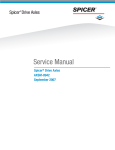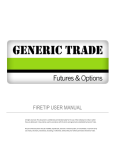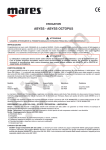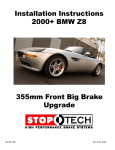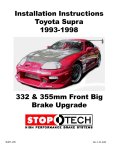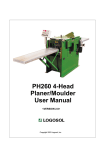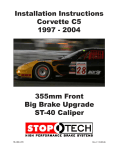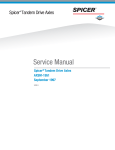Download BENDIX BRSM0890 User's Manual
Transcript
Dana®Spicer ® Brakes 16.5" Series S-Cam XTRALIFE TM XTRALIFE II TM Cast P-Series Service Manual BRSM-0890 October 1997 For the most current information, visit the Roadranger web site at www.roadranger.com TABLE OF CONTENTS Identification ..................................................................... 2 Brake Components (Standard/Xtralife) ...................... 3 Brake Components (Cast Series) .................................. 4 Brake Components (XL II Series) .................................. 5 Brake Components (“P” Series) .................................... 6 General Precautions ......................................................... 7 Preventative Maintenance ............................................... 9 Brake Disassembly ............................................................ 11 Inspection of Parts ........................................................... 12 Brake Assembly ................................................................. 15 Trouble Shooting Charts ................................................. 18 Reline Procedure ............................................................... 21 GENUINE SPICER SERVICE PARTS Should a brake assembly require replacement component parts, it is recommended that Spicer Brake Service Parts be used. Spicer Brake Service Parts are manufactured under the same rigid specification as are original equipment brake components. This assures the customer who uses genuine Spicer service parts, maximum reliability for a Spicer Brake assembly. They may be obtained through your vehicle manufacturer. The use of non-original Spicer service parts may cause premature compontent failure and may void the warranty. The items included in this book are currently being offered as service parts at the time of printing. The part numbers and illustrations are provided specifically for reference purposes only. Therefore, Spicer reserves the right to update this manual without notice or liability. i IDENTIFICATION The brake assembly may be identified by a tag which is located on the camshaft bracket cylinder, near the grease fitting. JULIAN DATE CODE 97 170 The mylar brake assembly tag contains the following: Dana assembly number, bar coded customer assembly number, and a numeric customer assembly number. MODEL YEAR DAY OF YEAR DANA ASSEMBLY NUMBER Two other markings that may be used to identify a Spicer Brake assembly are located on the assembly's components. "Spicer" will be cast into the spider assembly just above the anchor pins. Also, the inside of the chamber bracket arm contains the following stamped part information: "Spicer", julian date code, and the part number. CUSTOMER BAR CODE NUMBER Brake Assembly Tag BUILD DATE (APR 1997 AND LATER) CUSTOMER ASSEMBLY NUMBER BRAKE ASSEMBLY TAG CHAMBER BRACKET ARM STAMPED PART INFORMATION Camshaft Bracket "SPICER" STAMPED PART INFORMATION (IN ONE OF THESE AREAS) Spider Camshaft MODEL IDENTIFICATION NUMBERING SYSTEM Model (165 = 16.5" Brake) (150 = 15" Brake) Alphabetical Code (i.e., WD = Brake Assembly) 165 WD 000 Sequential Assembly Numbers 0 2 BRAKE COMPONENTS STANDARD/ XTRALIFE 16.5" Retaining Ring Camshaft Adjusting Washers (Shims) Camshaft Bushing Grease Fitting Steel Spacer Grease Seal Air Chamber Bracket Assembly Bracket Mounting Bolt (70 - 80 Lb-Ft) (95 - 108 N-m) Lock Washer Camshaft Bushing Grease Seal Dustshield Mounting Bolt 3/8 in. - 16 (20 - 28 Lb-Ft) (27 - 38 N-m) Lock Washer Spider Steel Spacer Plate Camshaft Cam Roller Shoe Return Spring Shoe and Lining Assembly Retainer Springs Return Spring Pin Lining Brake Lining Rivet 3 BRAKE COMPONENTS 16.5" CAST SHOE SERIES Retaining Ring Camshaft Adjusting Washers (Shims) Camshaft Bushing Air Chamber Bracket Assembly Steel Spacer Grease Seal Grease Fitting Bracket Mounting Bolt (70 - 80 Lb-Ft) (95 - 108 N-m) Lock Washer Camshaft Bushing Grease Seal Spider Dustshield Mounting Bolt 3/8 in. - 16 (20 - 28 Lb-Ft) (27 - 38 N-m) Lock Washer Dust Shield Half Steel Spacer Plate Camshaft Anchor Pin Retainer Clip Anchor Pin Retainer Clip Washer Cam Roller Anchor Pin Bushing Grease Fitting Anchor Pin Shoe and Lining Assembly Lining Brake Lining Bolt Shoe Return Spring Washer Brake Lining Nut (15-17 Lb-Ft) (20-23 N-m) Lock Washer Brake Lining Bronze Bushing 4 BRAKE COMPONENTS 16.5" XL II SERIES BRAKE Retaining Ring Camshaft Adjusting Washer Steel Spacer Grease Seal Camshaft Bushing Grease Fitting Camshaft Bracket Camshaft Bushing Grease Seal Bracket Mounting Bolt (70 - 80 Lb-Ft) (95 - 108 N-m) Dust Shield (Half) Lock Washer Spider Dustshield Mounting Bolt 3/8 in. - 16 (20 - 28 Lb-Ft) (27 - 38 N-m) Steel Spacer Plate Cam Roller Lock Washer Camshaft Anchor Pin Cam Roller Retainer Clip Anchor Pin Bushing Dust Shield (Half) Shoe Return Spring Return Spring Pin Brake Lining Rivet Lining 5 Shoe Retainer Spring Shoe and Lining Assembly BRAKE COMPONENTS 16.5" P SERIES BRAKE Retainer Ring Camshaft Adjusting Washer Steel Spacer Grease Seal Camshaft Bushing Grease Fitting Camshaft Bracket Camshaft Bushing Grease Seal Bracket Mounting Bolt (70 - 80 Lb-Ft) (95 - 108 N-m) Dust Shield (Half) Lock Washer Spider Dustshield Mounting Bolt 3/8 in. - 16 (20 - 28 Lb-Ft) (27 - 38 N-m) Cam Roller Retainer Clip Steel Spacer Plate Lock Washer Camshaft Anchor Pin Washer Snap Ring Anchor Pin Bushing Cam Roller Dust Shield (Half) Shoe Return Spring Lining Return Spring Pin Brake Lining Rivet 6 GENERAL PRECAUTIONS IMPOR TANT IMPORT READ THIS SECTION BEFORE ST AR TING STAR ARTING ANY SER VICE PROCEDURES SERVICE Never remove a component or pipe plug unless you are certain all system pressure has been depleted. All Spicer original equipment or service parts for steering and drive axle brakes are manufactured using non-asbestos brake lining. It is recommended that original Spicer service parts be used when brake maintenance is necessary. SAFETY PRECAUTIONS Proper service and repair of vehicle components is important to the safe and reliable operation of all motor vehicles. This applies particularly to brakes such as the ones described in this manual. The procedures recommended and described in this manual are tested, effective methods for performing service operation. Follow each procedure closely, making use of both the text and pictures. Some of these service procedures show the use of certain tools designed especially for the operation being performed. It is not mandatory that these tools be used; they are shown only as preferred means of performing the operation. It is not practical to anticipate and advise the service trade of all possible alternate service methods, and of all possible hazardous consequences that could result from any particular method. Accordingly, anyone who uses a service procedure or tool different than shown must insure that their safety, and that the vehicle’s safety will not be jeopardized by the service method selected. 2. Never exceed recommended air pressure and always wear safety glasses when working with air pressure. Never look into air jets or direct them at anyone. 4. Never attempt to disassemble a component until you have read and understand recommended procedures. Some components contain powerful springs and injury can result if not properly disassembled. Use only proper tools and observe all precautions pertaining to use of those tools. 5. Use only genuine Spicer replacement parts and components. A. Only components, devices, mounting and attaching hardware specifically designed for use in air brake systems should be used. B. Replacement hardware, tubing, hose, fittings, etc. should be of equivalent size, type, length and strength as the original equipment. C. Make certain that when replacing tubing or hose, all supports, clamps or suspending devices that were originally installed by the vehicle manufacturer are reinstalled. 6. CA UTION: When w orking on or ar ound air CAUTION: working around br ak ems and component s, the follo wing brak akee ssyyst stems components, following pr ecautions should be observ ed: precautions observed: 1. 3. Devices with stripped threads or damaged parts should be replaced. Repairs requiring machining should not be attempted. CAUTION Always block vehicle wheels. Stop engine when working under a vehicle. Depleting vehicle air system pressure may cause vehicle to roll. Keep hands away from chamber push rods and slack adjusters; they may automatically apply as system pressure drops. BRAKE LININGS CONTAIN NON-ASBESTOS FIBERS BREATHING BRAKE DUST MAY BE HAZARDOUS TO YOUR HEALTH AND MAY CAUSE SERIOUS RESPIRATORY OR OTHER BODILY HARM. AVOID CREATING DUST DO NOT REMOVE BRAKE DRUM WITHOUT PROPER PROTECTIVE EQUIPMENT. DO NOT WORK ON LININGS WITHOUT PROPER PROTECTIVE EQUIPMENT. DO NOT REPLACE LININGS WITHOUT PROPER PROTECTIVE EQUIPMENT. DO NOT ATTEMPT TO SAND, GRIND, CHISEL, FILE, HAMMER OR ALTER BRAKE LININGS IN ANY MANNER WITHOUT PROPER PROTECTIVE EQUIPMENT. Never connect or disconnect a hose or line containing air pressure. It may whip as air escapes. FOLLOW 0.S.H.A. STANDARDS FOR PROPER PROTECTIVE DEVICES TO BE USED WHEN WORKING WITH BRAKE MATERIALS. 7 GENERAL PRECAUTIONS (CONTINUED) PREPARATION 1. Park vehicle on a level surface and prevent movement by means other than the brakes. 5. 2. If equipped with spring brakes, cage the spring on all axles to be worked on. 3. Raise the axle, to be worked on until the tires clear the ground. Support axle with heavy duty jack stands. WARNING: The long tterm erm effect xposur o noneffectss of eexposur xposuree tto ea ting a sbe st os ha Avv oid cr crea eating sbest stos hass no nott been de dettermined. A dust when per forming service on br ak ssemblie s. performing brak akee aassemblie ssemblies. xposur o br ak aEx ce ssiv xposuree tto brak akee dust ma mayy cause rree spir spiraExce cessiv ssivee eexposur tory damage or oother ther bodil bodilyy harm. 4. "Back-off " slack adjuster by turning adjusting nut until the brake shoes are fully retracted. Remove wheels and drums using the procedures specified in the vehicle maintenance manual. Safety glasses should be wor n worn at all times when assembling or disassembling brakes. CA UTION: RRockw ockw ell Aut o Slacks rrequir equir wl CAUTION: ockwell Auto equiree the pa pawl a ssembl o be rremo emo ssemblyy tto emovv ed befor beforee turning the adjust adjust-ing nnut. ut. WARNING: Ne ork under a vvehicle ehicle suppor Nevv er w work supportted onl and. onlyy bbyy a jack. Alw Alwaays use a jack st stand. 8 PREVENTATIVE MAINTENANCE A schedule should be eest st ablished for periodic stablished adjustment, inspection and lubrica tion. This schedlubrication. ule is de om vvehicle ehicle oowner/oper wner/oper dettermined fr from wner/operaa tor orss experience and the ttype ype of oper operaa tion tion. CA UTION: Drums displa ying hea CAUTION: displaying heatt checks with a contin uous length of four inche continuous inchess or mor moree and ext ends ar ound the edge of the drum should be xtends around replaced. See FFigur igur iguree 1. BRAKE DRUMS Inspect for heat checks, grooves, hot spots, glazing, cracks, and out of round. Drums which are glazed, grooved, or have moderate heat checking may be resurfaced and returned to service. The drum should not be used if it exceeds the manufacturer’s recommended maximum diameter stamped on the drum. BRAKE ADJUSTMENT Brakes should be adjusted whenever the air chamber push rod stroke exceeds the maximum distance according to the chart shown in F igur iguree 2 2. To determine if brake adjustment is required measure the push rod stroke with the brakes applied as shown in F igur iguree 3 on 0. page 1 10. F igur iguree 1 RECOMMENED AIR BRAKE ACTUATOR SERVICE STROKE Chamber Size Type Standard Chamber Rated Stroke Long Stroke Chamber Max Readjust Stroke Rated Stroke Max Readjust Stroke 12 1.75 1.38 2.00 1.50 16 2.25 1.75 2.50 2.00 20 2.25 1.75 2.50 2.00 24 2.25 1.75 2.50 2.00 30 2.50 2.00 2.75 2.25 36 3.00 2.25 - - Source: The Maintenance Council RP 635 F igur iguree 2 9 PREVENTATIVE MAINTENANCE BRAKE LUBRICTION Lubricate the camshaft thru the grease fitting on the camshaft bracket with the chassis lube specified by the vehicle manufacturer. Lube once every six months or at every chassis lubrication. MEASURING PUSH ROD STROKE 1. Measure the distance between the air chamber mounting face and the center of the clevis pin, with brakes released. 2. Make an 70-90 PSI application and hold it. Measure the distance between the air chamber and the mounting face and the center of the clevis pin. 3. Subtract measurement A from measurement B. If this measurement equals or exceeds the maximum readjust stroke the brakes need to be adjusted. See FFigur igur iguree 3. 4. If adjustment is required, spin the wheel slowly and adjust the slack adjuster just enough for wheel to spin freely. Be sure to adjust brakes equally on each axle. 5. 6. BRAKE RELINE The life of the brake lining is dependent on many factors such as the material of the lining, type of operation the vehicle is used for, geographic terrain, maintenance practice of the shop, and the driver of the vehicle. If driving conditions require frequent braking, lining replacement will be required more often. FOR RIVET LINING Reline when thickness of lining is 1/4 " at thinnest point, or 1/16" above rivet head. FOR CAST SHOES WITH BOLTED LININGS Reline when lining is below wear indicator line or thickness is .31" at the thinnest point or 1/16" above bolt head. Apply and release brakes and observe slack adjusters. Both slacks on each axle should respond rapidly and in unison during application and release. BRAKE OVERHAUL As often as necessary to maintain satisfactory brake performance. When overhauling the brakes, provide equal service to both the left and right side of an axle. Drive vehicle at a low speed in a safe area and check for brake effectiveness prior to putting back in service. B A A. Released Position B. Applied Postion FFigur igur iguree 3 10 BRAKE DISASSEMBLY CAST SHOE & "P" SERIES 1. Insert sturdy lever between end of shoe and spider. Pry shoe away from cam until cam rollers can be removed. Repeat procedure for opposite shoe. SLACK ADJUSTER REMOVAL 1. Disconnect clevis from slack adjuster arm by removing the clevis pin or pins depending on type of slack adjuster. 2. Unhook shoe return spring by pushing shoes together, allow tension on spring to be reduced. 2. Remove retaining ring and shims from splined end of camshaft. 3. Discard shoe return spring and replace with new at time of reassembly. 3. Remove slack adjuster from the camshaft. 4. Remove snap ring from anchor pin and push anchor pin through. CA UTION: Do no er tto o CAUTION: nott hammer on slack adjust adjuster remo o the slack adjust er and/ emovv e. Serious damage tto adjuster or the camshaft spline spliness ma mayy rree sult. NO TE: T ap lightl NOTE: Tap lightlyy with br braa ss drift if anchor pin will no nott push out with finger finger.. 5. Remove brake shoe and place on floor. Repeat procedure for opposite shoe. CAMSHAFT REMOVAL 1. Before removing camshaft check to see if cam bushings age 1 2. igur need replacement. See FFigur iguree 4 on PPage 12. STANDARD, XL, & XLII SERIES 1. Insert sturdy lever between end of shoe and spider. Pry shoe away from cam until cam rollers can be removed. Repeat procedure for opposite shoe. 2. Unhook shoe return spring by pushing shoes together, allow tension on spring to be reduced. 3. Discard shoe return spring and replace with new at time of reassembly. 2. Remove spacer from between slack adjuster and cam shaft bracket. 3. Grasp camshaft at the camshaft head and pull in the outward direction to remove. 4. Clean and inspect camshaft splines and head. AIR CHAMBER/ CAMSHAFT BRACKET ASSMEBLY REMOVAL 1. Remove two nuts and washers that secure brake chamber to camshaft bracket. 4a. S TAND ARD & XL ANDARD Remove shoes by rotating the bottom shoe off the anchor pin to release the tension on the two retaining springs. 2. Remove brake chamber and temporarily set it aside. CA UTION: Do no CAUTION: nott le lett the air chamber hang bbyy the air line liness 4b. XLII SERIES Remove snap ring from anchor pin and push anchor pin through. 3. Remove four bracket mounting bolts and lock washers. 5. Remove the two retaining springs and discard. 4. Remove bracket assembly from spider. 6. Remove shoes from spider. 11 BRAKE DISASSEMBLY (CONTINUED) SPIDER REMOVAL 1. Mark the postion of the spider on the axle (L.H. or R.H.) and the orientation on the axle flange by making a reference mark on the spider and flange. See FFigur igur iguree 4. 2. Remove the spider to axle mounting bolts. 3. Remove spider. DUST SHIELD REMOVAL 1. Mark dust shields (upper left, lower right, etcprior to removal. 2. Detach dust sheild by removing the six cap screws using a 9/16" socket. Do not remove dust shield unless there is apparent damage. F igur iguree 4 INSPECTION OF PARTS AIR CHAMBER BRACKET ASSEMBLY 1. Check assembly for bent chamber bracket, broken welds, cracks, and correct alignment. 2. Inspect camshaft bushings for signs of wear. Bearing surfaces should be smooth and free of any pitting or fractures. Insert camshaft and measure looseness up and down side to side at both ends with a dial indicator. If more than .030” movement, igur replace bushings and/or camshaft. See FFigur iguree 5. F igur iguree 6 equir thatt a bushing rrequir equiree s NOTE: dettermined tha NO TE: If it is de r eplacement, bo th camshaft bushings and seals both should be rreplaced. eplaced. All CAS T SHOE and P SERIES CAST br ak onze cam bushings. The SST TAND ARD, brak akee s ha havve br bronze ANDARD, XL, and XLII SERIES br ak ylon bushings with brak akee s use nnylon the br onze bushing aass an op tion. bronze option. CAMSHAFT 1. Inspect camshaft spline and body for chips and excessive deformation. Replace as necessary. See FFigur igur iguree 6. 2. Inspect cam head for cracks, and its roller surfaces for flat spots, brinneling, or ridges. NO TE: Un usual w ear pa NOTE: Unusual wear pattterns which ma mayy indica indicatte an out -of-squar eplace damaged camout-of-squar -of-squaree condition. RReplace shaft s. shafts. F igur iguree 5 12 INSPECTION OF PARTS SPIDER 1. Inspect for cracked or broken surfaces on the spider at the cam, anchor pins, and mounting bolt holes. Replace any spider with visible damage. Do not attempt to weld or repair the spiders. See F igur iguree 7 7.. SHOES AND LINING STANDARD, XL, XL II AND P SERIES 1. Check shoes for bent shoe ribs, cracks in shoe table welds or ribs, and elongated rivet holes. Replace shoes if any of these conditions exist. See F igur iguree 9. XLII, P, & CAST SHOE SERIES 2. Measure the shoe span by loosely installing the anchor pin and cam roller in the appropriate ends of the shoe rib. If the distance from center of anchor pin to center of cam roller exceeds 12.76 inches replace shoe. 3. Check linings and replace when any of the following conditions exist: See page 21 for reline procedure. 2a 2a. Check the inside diameter of the anchor pin hole with bushing in place. Diameter must not exceed 1.282”. Replace bushing if necessary. STANDARD & XL SERIES 2b. The anchor pins are staked into the spider and are not serviced separately. If the pins are loose or grooved more than .030 inch, the spider assembly must be replaced. A. Total lining thickness at thinnest point is 1/4" or less, or 1/16" above the rivets. B. Linings are cracked or worn in an unusual or odd pattern. For example: lining wear tapered from side to side across the shoe table. Un usual wear pattern can indicate damage to foundation brake parts. C. Rivet holes are elongated in lining or shoes. D. Lining is oil soaked. F igur iguree 7 E. Linings can be moved by hand because of loose rivets. ROLLERS AND ANCHOR PINS, BUSHINGS 1. Inspect rollers and anchor pins for flat spots, galling, broken or cracked surfaces. Replace as igur necessary. See FFigur iguree 8. F igur iguree 9 F igur iguree 8 13 INSPECTION OF PARTS (CONTINUED) SHOES AND LINING CAST SHOE TYPE 1. Check shoes for cracks and elongated bolt holes. 2. Measure the shoe span by loosely installing the anchor pin and cam roller in the appropriate ends of the shoe rib. If the distance from center of anchor pin to center of cam roller exceeds 12.76 inches replace shoe. 3. Check linings, replace when any of the following conditions exist. BRAKE DRUMS 1. Inspect drums for cracks, heat checking, glazing, grooving, severe out-of-round condition or bell 25 T .I.R. (T o tal mouthing m ust no nott eexx ceed .0 .02 T.I.R. (To Indica eading) Replace any drums that are Indicattor RReading) cracked. The drum should not be used if it exceeds the manufacturer’s recommended maximum diameter stamped on the drum. 2. A. Total lining thickness at thinnest point is .31” or less than 1/16” above screw head. Also, if the material is worn beyond the wear groove on the side of the lining. B. Linings are cracked or worn in an unusual or odd pattern. For example: lining wear tapered from side to side across the shoe table. Un usual wear pattern can indicate damage to foundation brake parts. C. Screw holes are elongated. D. Lining is oil soaked. E. Lining can be moved by hand. (loose bolts) Measure the drum I.D. to be sure the maximum limit allowed (stamped on drum) has not been exceeded due to wear or machining. CA UTION: Drums displa ying hea CAUTION: displaying heatt checks with a contin uous length of four inche continuous inchess or mor moree and ext end ar ound the edge of the drum should be xtend around replaced. See FFigur igur 0. iguree 1 10. F igur 0 iguree 1 10 TRANSIT BRAKE (CAST SHOE ONLY) DRUM/ LINING CROSS REFERENCE CHART 1. 2. When installing new drums always use standard thickness lining. If used drums are rebored carefully measure inside diameter (in several places) of rebored drum. Refer to the chart below for proper oversized lining required based on drum measurements. CA UTION: Ne ak CAUTION: Nevver shim br brak akee linings. See page eline Pr ocedur e, for mor 21, RReline Procedur ocedure, moree de dettail. LINING MAXIMUM THICKNESS (IN) DRUM DIA. (IN) AT RELINE .867” (Standard Thickness) 16.500”- New .927” (1X Oversize) 16.620” .987” (Premium Thickness) Over 16.620” 14 CAUTION: Maximum discard diameter is 16.750” BRAKE ASSEMBLY CHAMBER BRACKET ASSEMBLY Seal Installation NO TE: Bo th lip seals point the same NOTE: Both dir ection, lip tto ow ar d the slack adjust er direction, ard adjuster Left Hand Cam Right Hand Cam Lip Seal Lip Seal F igur 2 iguree 1 12 End Cam Slack A djust er End Adjust djuster CA UTION: Left Hand and Right Hand does not CAUTION: establish which side of the vehicle the cam goes on. Left and right are used to identify the two different types of cams only. A ctua ack ctuattor Br Brack ackee t and Cam T ube Tube Spider F igur 1 iguree 1 11 CA UTION: The lip of the gr ea se seals m ust be CAUTION: grea ease must inst alled corr ectl o pr installed correctl ectlyy tto preev ent posssible damage. The lip of the seal tha alled in the spider end m ust thatt is inst installed must ent er the opening fir st. The lip of the seal tha enter first. thatt is ust inst alled in the opposit oppositee end of the cam tube m must installed all the chamber ent er la st. See FFigur igur 1. Inst Install enter last. iguree 1 11 ssembl o the spider br ack ssemblyy ont onto brack ackee t and the cam tube aassembl using four cap scr s. T or que tto o scree ws and lockw lockwaa sher shers. Tor orque 70-8 0 Lb-Ft. 0-80 3. Coat bushing, seals, journals and camshaft spline with light film of chassis lube. 4. Carefully install camshaft through the chamber bracket tube, from spider end. Cam must rotate freely when turned by hand. IMPOR TANT eful no o damage the gr ea se IMPORT ANT:: Be car careful nott tto grea ease seals. SPIDER 1. Use a wire brush to remove heavy contamination from the spider mounting flange, knuckle, spider, brake drum exterior, and chamber mounting bracket. SPICER S-CAM BRAKE RETURN SPRINGS Br ak Brak akee Serie Seriess Install the spider and chamber bracket assembly onto the axle flange. Be sure spider is properly oriented, as noted during disassembly. Tighten mounting fastener to manufacturer's specifications. CAMSHAFT 1. Prior to reassembly, verify the part number is correct there are L.H. and R.H. camshafts and they igur 2. can not be interchanged. See FFigur iguree 1 12. Place steel spacer plate over splined end and slide ak next to cam head. (See br brak akee component componentss on page pagess 3-6) IMPOR TANT IMPORT ANT:: Do no nott coa coatt "S" cam head. If removed, reinstall the dust shields. Tighten the six cap screws and lockwashers to 20-28 Lb-Ft of torque. 2. 2. 15 Re turn Springs P/N & Color Standard 165WJ110 Dark Blue XL & Cast Shoe 165WJ115 White XLII 165WJ129 Light Blue BRAKE ASSEMBLY (CONTINUED) BRAKE SHOE ASSEMBLY the S-cam and the slots in the end of the brake shoe. Make sure the cam rollers are in the lowest position on the cam. Repeat procedure for opposite side. STANDARD, XL & XL II SERIES 1. Install new return spring pins: A. St andar d Serie Standar andard Seriess - Wireform pin installed in shoe ribs with mallet. CAST SHOE SERIES 1. Apply a thin film of Lubriplate 630-A grease or its equivalent to the anchor pin. B. XL Serie Seriess - 2 piece kit assembly consisting of inner pin and outer pin. 2. 3. Apply a thin film of Lubriplate 630-A grease or its equivalent to the anchor pin. Install new brake retaining springs in the anchor end of shoes. Place the top shoe onto the spider by engaging the open slots on the end with the retaining springs onto the anchor pin. Place opposite end of the shoe against the S-cam. Swing the lower shoe, with springs attached, back until slots in the shoe engage the anchor pin. Rotate the shoe toward the S-cam. Lower shoe may require support while completing assembly. 2. Place snap ring on anchor pin end with grease fitting. Place thin spacer onto anchor pin. 3. Align anchor pin end of cast shoe with spider bore. 4. Install anchor pin through backside of shoe and spider. Repeat procedure for opposite shoe. 4a. St andar d Serie Standar andard Seriess - Utilize leg on shoe return spring to aid in assembly. Place the one hook of the brake shoe return spring onto the return spring pin. Hold shoes firmly against the S-cam. Push the other hook of the brake shoe return spring over the opposite return spring pin until it snaps in place. 4b. XL/XL II Serie Seriess - place the one hook of the brake shoe return spring onto the return spring pin located between the shoe ribs. Hold both shoes against the S-cam head. Push the other hook of the return spring over the opposite shoe spring pin until it snaps in place. 5. Apply a thin film of Lubriplate 630-A grease or its equivalent to the cam roller journal, and the roller side only. Do not put grease on the end of the roller which contacts the cam head. 6. Insert sturdy lever between end of shoe and the igur 3 . Pry away from return spring pin. See FFigur iguree 1 13 the cam until cam rollers can be installed between F igur 3 iguree 1 13 16 5. Place thin spacer onto opposite side of anchor pins and install snap rings. 6. Hook shoe return spring by pushing shoes together. The cast shoe does not have a separate return spring pin. The spring hook-up feature is designed into the shoe casting. 7. Insert sturdy lever between end of shoe and spider. Pry shoe away from cam until cam rollers can be installed. Repeat procedure for opposite side. See F igur 3. iguree 1 13. BRAKE ASSEMBLY (CONTINUED) “P” SERIES 1 . Install new return spring pins. See FFigur igur 4. iguree 1 14. 2. Align lower end of fabricated shoe with spider bore. 3. Place snap ring on anchor pin end with grease fitting. Place thin spacer onto anchor pin. 4. Install anchor pin through backside of shoe and spider. 5. Apply a thin film of Lubriplate 630-A grease or its equivalent to the anchor pin. 6. Place thin spacer onto opposite side of anchor pin and install snap ring. 7. Hook shoe return spring by pushing shoes together. 8. Insert sturdy lever between end of shoe and spider. Pry shoe away from cam until cam rollers can be installed. Repeat procedure for opposite side. F igur 4 iguree 1 14 NO TE: Due tto o the man tions of slack NOTE: manyy combina combinations ak s, follo w vvehicle ehicle adjust er adjuster erss and br brak akee chamber chambers, follow man ufactur er’ tions and pr ocedur manufactur ufacturer’ er’ss specifica specifications procedur oceduree s for a ssembl ssemblyy and final adjustment. SLACK ADJUSTER ASSEMBLY 1. Reinstall thick camshaft flatwasher. 3. Spin the wheel slowly and adjust the slack adjuster until wheel will no longer turn. Back off slack adjuster just enough for wheel to spin freely. Be sure to adjust brakes equally on each axle. 2. Install new slack adjuster, shims, and a new snap ring (In that sequence) into the splined end of the camshaft. 3. Adjust camshaft end play of the camshaft to between .005" and .045" by using the appropriate number of shims. Make sure the snap ring is seated into the groove at the end of the splined camshaft. 4. Apply the release brakes and observe slack adjusters. Both slacks on each axle should respond rapidly and in unison during application and release. BRAKE LUBRICATION 1. Lubricate the camshaft bushings by filling the camshaft tube with lube through the zerk fitting provided. Fill until grease is forced out in the area of the slack adjuster. Grease should not appear at the cam head end. If it does, the seal has not been properly installed, or the old seals should be replaced. 5. Drive vehicle at a low speed in a safe area and check for brake effectiveness prior to putting back in service. 2. Reinstall brake drums and wheels. Torque and adjust wheel bearings to manufacturer’s specifications. 17 FOUNDATION BRAKE TROUBLESHOOTING CHART SYMPTOM 1. Degraded brake performance. CAUSE REMEDY A. Too much push rod free travel. A. Adjust brake. B. Severely glazed or worn out linings. B. Deglaze linings or replace. C. Grease or oil on linings. C. Replace linings. D. Worn, seared, heat checked, cracked drums. D. Replace part. E. Push rod length too long. E. Adjust clevice, shorten push rod length F. F. Air chamber in wrong position. Reposition. G. Broken or bent parts. G. Replace part. H. Flat spots on cam or rollers. 2. Slow brake application. A. Cam shaft bushings binding. H. Replace flat-spotted parts. A. Clean and lubricate. Check for seal leakage. 3. Slow brake release. A. Binding cam shaft and bushing. A. Clean and lubricate. B. Weak or broken shoe return spring. B. Replace part. C. Replace flat-spotted parts. C. Flat spotted cam or rollers. 4. Grabbing or pulling. A. Grease, oil, or dirt on linings. A. Replace lining. B. Glazed linings. B. Deglaze lining or replace. C. Brake linings not a balanced set, different friction codes, or lining brand. C. Replace linings. D. Loose or broken linings. D. Replace linings. E. Brake drum out-of-round. E. Turn, per manufacturer's specifications. F. F. Defective brake drum. Replace part. G. Clevis pin or camshaft binding at one or more wheels. G. Clean and lubricate. H. Defective slack adjuster. H. Replace part. I. Uneven brake adjustment (side to side). I. Adjust brakes. J. Broken or bent parts. J. Replace part. K. Loose spider or drum mounting bolts. K. Inspect and replace as necessary. L. Different air chamber size or slack adjuster length (side to side). L. Use same size and type both ends of the axle. 18 BRAKE SHOE & LINING TROUBLESHOOTING CHART SYMPTOM 1. Poor lining to drum contact. 2. Linings tapered across width. 3. Unequal wear on same brake. 4. Unequal wear side to side brakes, same axle. 5. Wear on edge of lining. 6. Glazed linings (hard & shiny). CAUSE REMEDY A. Bell-mouth drum. A. Replace part. B. Bent brake spider. B. Replace part. C. Bent or stretched brake shoe. C. Replace part. D. Undersize linings. D. Replace linings. E. Loose wheel bearing. E. Correct as required. F. F. Improper lining grind. Regrind linings to drum radius minus .015" A. Bell-mouth drum. A. Replace parts. B. Bent brake shoe. B. Replace parts. C. Bent brake spider. C. Replace part. D. Loose wheel bearings. D. Correct as required. A. Mismatched lining friction codes. A. Replace linings. B. Stretched shoe. B. Replace parts. C. Flat spots on cam or roller. C. Replace flat-spotted parts. D. Worn anchor pin. D. Correct as required. E. Worn camshaft or bushings. E. Replace part. A. Mismatched lining friction codes. A. Replace linings. B. Seized or binding camshaft. B. Clean and lubricate. C. Brake drum surface in poor condition. C. Replace or turn I.D. D. Loose wheel bearing. D. Correct as required. E. Relining one brake. E. Reline both brakes together. A. Wrong width lining. A. Replace linings. B. Holes improperly drilled in lining. B. Replace linings. C. Wrong drum, or improperly machined. C. Replace or turn I.D. D. Loose wheel bearing D. Correct as required. E. Improper wheel bearing or cone. E. Correct as required. F. F. Bent brake shoe. Replace part. G. Bent brake spider. G. Replace part. H. Worn axle spindle. H. Correct as required. A. Overheating, due to unbalanced braking system. A. Correct as required. B. Wrong type linings for service involved. B. Replace linings. 19 BRAKE SHOE AND LINING TROUBLESHOOTING CHART 7. Scored or grooved linings and drum. 8. Loose lining. 9. Cracked lining at rivet holes. 10. Elongated rivet holes. A. Scored or worn drum, not machined at reline. A. Replace or re-machine. B. Abrasive material between lining and drum. B. Clean, remove dirt and debris. A. Improper size rivets (too long, too short, improper diameter). A. Re-rivet. B. Improper crimping of rivet. B. Re-rivet. C. Enlarged rivet holes in shoe. C. Replace part. D. Incorrect lining hole size or counter bore depth. D. Replace linings. E. Rust build up on shoe table. E. Clean, remove rust and paint shoe. A. Wrong type rivets. A. Replace part. B. Rivets not properly crimped. B. Replace lining. C. Dirt or rust on shoe table. C. Clean, remove dirt and debris. D. Wrong size lining counter bore. D. Replace linings. A. Loose rivets. A. Replace shoe and lining. BRAKE DRUM TROUBLESHOOTING CHART SYMPTOM 1. Brake drum heat checked. 2. Excessive scoring of drum. CAUSE A. Out round brake drum. REMEDY A. Turn, per manufacturer’s specifications. B. Eccentric mounting of drum. B. Inspect wheel and drum and replace defective part. C. Loose wheel bearing. C. Correct as required. D. Glazed linings. D. Replace linings. E. Improper friction materials for duty cycle of vehicle. E. Consult vehicle manufacturer. F. Overworked brake. F. Check proper brake balance. G. Driver abuse. G. Correct as required. H. Wrong drum, too light. H. Replace part. A. Defective brake lining. A. Replace linings. B. Abrasive material between lining and drum. B. Clean, remove dirt and debris. C. Soft drum. C. Check hardness on flange. D. Excessive lining wear, rivets contact ing drum. D. Replace lining. E. Drum not turned at last reline. E. Turn per manufacturer’s specifications. F. Build up of abrasives in rivet holes. F. Blow out debris. 20 RELINE PROCEDURE Bolts/Rivets Removal When removing bolts/rivets from the brake shoes, be careful to avoid doing any damage to the holes in the shoe. Do not use a chisel to shear them off. The force will elongate the bolt/rivet holes. Neglecting any elongated holes may result in a loose fitting installation. If holes are burred, they should be filed down flush with the shoe table. Cleaning the Shoe Rust often developes on the surface of the shoe table under the brake lining or blocks. During every reline job, shoe tables should be cleaned thoroughly. The best procedure is to steam clean the entire shoe or put it into a degreaser. F igur 6 iguree 1 16 The installation should be checked by attempting to insert a .006" feeler gage between the lining and shoe table. It should not be possible to insert the feeler gage 6. The only igur iguree 1 16. anywhere along the edge. See FFigur exception is at each end and beyond the last row of rivets/bolts. A slightly larger clearance may exist in these areas. After cleaning the shoe, the shoe should be scraped clean of rust and scale. Any burrs or nicks should be filed smooth. At the same time, the entire shoe should be examined to see if it is worn or bent. Shoe Inspection The shoe should be either reconditioned or discarded. It is also necessary to check for flat spots on the shoe that can be caused by cleaning away the rust from the area that was under the block previously. This can cause a mismatch of shoe and lining arcs. After the shoe is cleaned and inspected, it should be given a coating of rust preventative paint. Treatment of a new, unpainted shoe is also suggested to prevent the initial rusting problem. Riveting Application Some brake failures result from the use of rivets which are too short, too long, or the wrong diameter. Incorrect setting of the riveting machine may induce other types of failures. The solid portion of the rivet should end just at the inner surface of the shoe. The hollow portion of the rivet should extend past the inner surface of the shoe. The proper size rivet must be used to completely fill the hole. Lining Installation IMPOR TANT ak IMPORT ANT:: Ne Nevv er shim the br brak akee linings. Brake noise may result because of cracked and/or loose lining since a tight installation is not possible with shims. The inside surface of the correct arc to match the shoe table, and the rivet/bolt holes in the linings will only line up with holes in the shoes when they are in direct contact. Prior to riveting/bolting be sure the holes in the lining blocks and the shoes are exactly matched. The sequence of riveting/bolting should be such that the center of the block is attached first and then the 2 for bolting sequence. ends. See page 2 22 USE ONL Y1 0-81/2 RIVETS ONLY 10-8 Brass plated steel rivets are recommened. The riveting machine must be adjusted so that the roll of the rivet is complete, but the rivet should not split. Always use a roll set, never a star set, when riveting brake linings. A star set does not compress the rivet and expand it to fill the hole. Consequently, the lining may work loose in service. 21 RELINE PROCEDURE Bolting Application Use 3/8 inch diameter copper alloy bolts. Torque bolts to 15-17 Lb-Ft (20-23 N-m) Follow the sequence below for the bolt application only. 16.5 x 6 inch 16.5 x 10 inch 15 11 10 17 7 8 11 9 12 14 19 13 20 18 3 5 4 10 1 2 1 6 7 22 6 8 2 5 3 12 16 4 9 Copyright Eaton and Dana Corporation, 2002. EATON AND DANA CORPORATION hereby grants its customers, vendors, or distributors permission to freely copy, reproduce and/or distribute this document in printed format. THIS INFORMATION IS NOT INTENDED FOR SALE OR RESALE, AND THIS NOTICE MUST REMAIN ON ALL COPIES. The Roadranger® System is an unbeatable combination of the best products from Eaton and Dana -- partnering to provide you the most advanced, most trouble-free drivetrain in the industry. And it's backed by the Roadrangers -- the most experienced, most expert, most accessible drivetrain consultants in the business. Visit our web site at www.roadranger.com. For spec'ing or service assistance, call 1-800-826-HELP (4357) 24 hours a day, 7 days a week, (Mexico: 001-800-826-HELP (4357)) for more time on the road. BRSM-0890 05/04 PDF Printed in USA


























